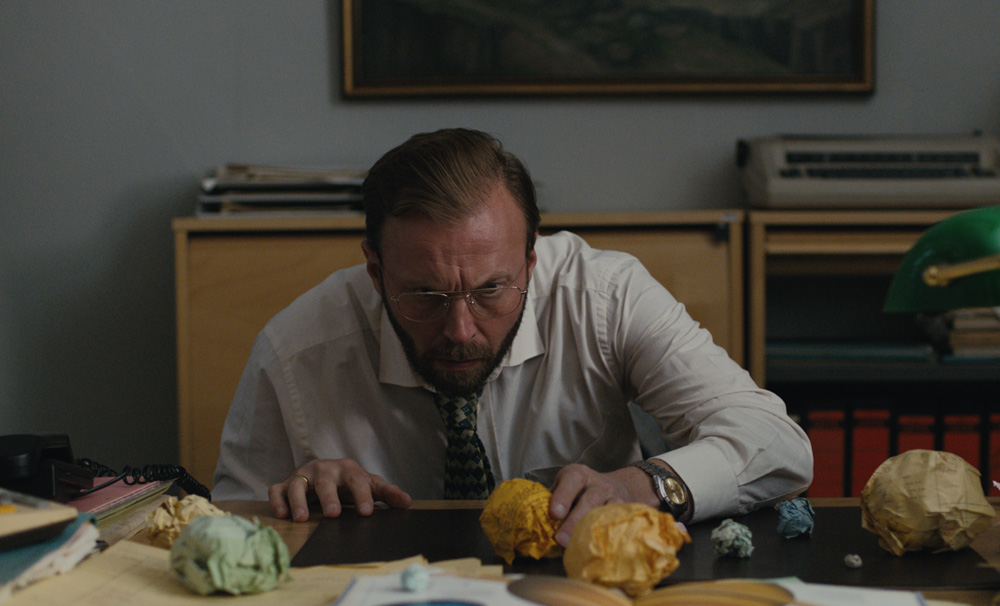Elfar Adalsteins got the warm and fuzzies as he read Jón Kalman Stefánsson’s novel “Summerlight…And Then Came the Night,” reminded of his youth in a small village in Iceland when the author wrote with such warmth about the community where everyone knew everyone else. Still, Adalsteins had to be nervous about knocking on the door of Kalman Stefánsson, who became a revered literary figure in the country in the years since, about the possibility of adapting the novel into a film.
“I was really scared,” Adalsteins said recently. “I wouldn’t say I was scared of him, but in awe. Now he’s written 14 books and three poetry [collections], and when I sat there and pitched him the story, I drank about a liter of coffee whilst doing it.”
Adalsteins has become a formidable artist in his own right since moving from producing to directing, making his debut with the tender John Hawkes/Logan Lerman drama “End of Sentence” and hardly shrinking from the challenge of not only tackling a beloved book, but one with several storylines to balance in Kalman Stefánsson’s sensitive survey of a town where many deferred their dreams in favor of keeping the status quo. It becomes easy to envision how Adalsteins saw a little bit of himself in a character known only as the Astronomer (Sveinn Ólafur Gunnarsson), gaining the nickname when he starts looking towards the stars after achieving all that he feels he can on earth after revitalizing the local economy with his efficient management of a knitting factory.
What starts as a hobby for the Astronomer with a telescope grows into an obsession that nurtures ambitions that he no longer has at his day job and “Summerlight…And Then Came the Night” reveals similar pent-up desires throughout the village where Jonas, a young son of a policeman, struggles to be the man his father wants him to become as he develops his own identity, Þuríður (Svandis Dora Einarsdottir), a nurse, longs for a partner as she takes care of the town’s elderly, and a farmer named Kjarten (Ólafur Darri Ólafsson) has nothing to complain about in his marriage to Asdis (Sara Dögg Ásgeirsdóttir), but nonetheless can’t resist a literal roll in the hay with his neighbor Kristin (María Dögg Nelson), if for no other reason than to shake things up in his life. Told with wry narration from an omniscient elder of the community, the film finds that it’s well worth stopping to look what’s stirring just underneath the surface in a place known for its beautiful scenery as people pass by on their way elsewhere.
Adalsteins has made a number of stops around the world to share this piece of home with the film, following a premiere in Reykjavik with bows at Talinn Black Nights Film Fest and Santa Barbara before settling into the U.S. for a theatrical run this week in New York and Los Angeles and the writer/director graciously took the time to talk about what drew him to Kalman Stefánsson’s tome in the first place, the demands of a big ensemble dramedy in a remote location and how he was able to bring his own personal experience in the film.
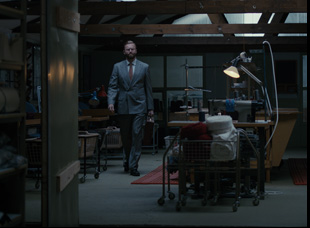
When I read [the novel] over a decade ago, it completely swept me off my feet. Jon Kalman is such a fantastic novelist. He goes straight through the heart and into the emotional system and stirs it up. I saw myself reflected in one of the stories and I was born and raised in a village like this, so I knew these people almost personally, and the vernacular and how the people behaved. I went to see Jon and asked him if he was willing to give me the rights for filming the book or write the adaptation. We discussed the pros and cons of making it into a film because in the book you have 10 stories that are very different and I said I wanted to choose these four that lend themselves to the cinematic structure. After he agreed, he said, “Just go make your film and do it an independent work, based on the book.” That was really important for me because it gave me some freedom to visit that village through the prism of the book.
Why did you gravitate towards the four narrative strands that you did?
I started writing the astronomer story and everything built from there. When I had these four, it was almost like a sculpting process where you start to throw things out and add to others. Midway through the process, it started to get a life of its own and dictate its own world. [Characters] start to tell you how they want to behave and how they want to talk. It gradually fell into place and ended up in this way. Give this to 100 directors, you’ll have obviously 100 different outcomes when you have such a vast amount of stories and threats to work with.
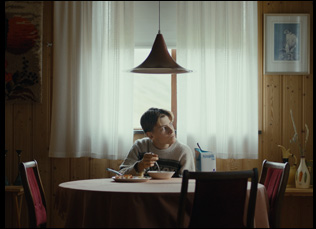
I suppose there are some correlations and similarities between the films. I think you always address something personal in each journey you undertake as a filmmaker, as a writer, as a novelist, as a poet, as a painter, so it deals with masculinity and fatherhood in a slightly different way. There is some understanding between a father and son and each other’s duties and how to live with a more open heart and one of my favorite scenes in the film when [the astronomer] cooks his son breakfast and by that action, he’s saying, “I’m sorry. I overshot, I got lost amongst the stars and the moons and the planets and he came back to ground and for the first time he was present.” I really liked that scene and the two actors portraying that were wonderful.
Was it exciting for you to go back to Iceland and pull from the acting community there?
Yeah, it was great and I was lucky enough that those who I sent the script to said, “Yeah, I’d love to do this film.” Working at the time of COVID, it really saved us that this was a town of 350 people that almost became our own private film set, so we could literally knock on doors and ask for permission to shoot in somebody’s house and people were so facilitating and helpful. That really made the film possible. But [casting] was also a headache because when you have 12 leading actors and four different story threads, nobody’s on set at the same time and this was a film that’s made for just a little over $2 million and we had to keep a tight lid on all costs, so people were being transported back and forth from Reykjavik, which is an eight-hour drive.
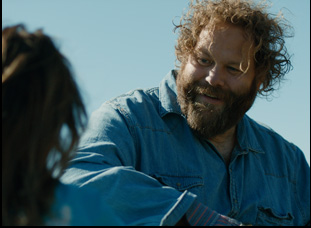
Yeah, I had scouted the village before and another that was quite similar in size, but different in aesthetics and what tipped the scale was the community hall and the police station — you had natural settings for some of the bigger scenes. And of course, there were these magical landscapes, which were important for me not to overuse. It wasn’t supposed to be a chocolate box version of Iceland. It was supposed to be both light and dark and beautiful and difficult and maybe a little bit ugly at times [as well as beautiful].
The knitting factory alone really conveys that throughout the film. What was it like to figure that out as a central location that could reflect change so much?
Literally, David Williamson, the [director of photography] who is Belgian, and I walked into a workshop where a woman takes driftwood and makes art out of it and said, “Oh, this looks good. Would it be okay if we film here?” And she said, “Yes,” and she emptied out her workroom, so we could build a knitting factory and restaurant. But we had to film in reverse, so the astronomers’s first scene was the final scene, and he said, “This was a little tough starting from the wrong end,” especially with the author of the book who plays the taxi driver, sitting on the opposite end of the table. That was the most pressure having the author in the in the room for his first scene. And I said to him, “Look, this guy is not comfortable with stepping out, so let’s use it as energy,” and it was a great scene to film.
When you grew up in a village like this yourself, was there was anything about that life that you wanted to that was important for you to convey?
I think it’s in all the scenes. I’m revisiting the cradle of my formative years through the prism of the book, so it was very much in me. And back when I was a teenager, we didn’t really travel much, so this was our cosmos and it was an interesting journey to go and revisit it. I think my experience combined with the premise of the book intertwines and that made it really exciting for me to work on.
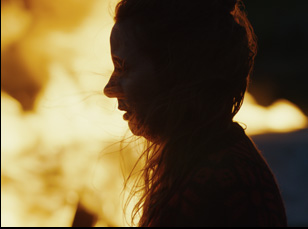
Well, Ola, that is a beautiful human being, both on the inside and outside and I think the world deserves to experience all of him. [laughs] He did such a wonderful job in the film. He’s so great to work with and one of our most prominent actors.
I wouldn’t want to spoil exactly what happens, but this has one of the most outrageous sex scenes imaginable. Was that a tricky to film?
Yeah, for sure. María Dögg Nelson, who plays [Olafur’s] counterpart in the scene was great. She studied MMA back in the day and her brother is a is a famous MMA fighter, so [the physicality] wasn’t an issue. But we went through [intimacy coordination of] “Is it allowed to touch here or do this?” And we could break. Then after a sex scene, I always ask the actors to come and view the scene to see what has been exposed and are they okay with it? So they have to greenlight the scene afterwards and say, “Yes, this is okay. This can go on into the editing room.” But they were both great on the day and there was a consensus of what you could and could not do and it turned into a visual wrestling match.
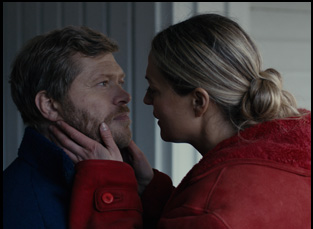
There were a few sleepless nights, but we got there in the end. It was a team effort. We had two editors Stefanía [Thors] and Tanya [Fallenius], which was great, and myself, working quite extensively to get the right tone because when you touch one thing at the front, it affects another thing at the back, so you’re always trying to [balance] the scales correctly and it swings almost like a heartbeat throughout. Some would say there’s a dramatic occurrence fairly late in the film possibly in the wrong place — or at least in an unusual place compared to normative narrative structure — but [then] you have to counterbalance it with with something beautiful and heartwarming and hopeful, so it was a balancing act.
It plays as a real crowdpleaser. What’s it been like to get it out into the world?
It’s great. The audience reception both here and when we when we screened in Santa Barbara and other places in the U.S. has been really great and heartfelt. That’s what you appreciate most as a filmmaker – to get the film in front of a live audience and the different interpretations you get from different cultures. That is it’s so rewarding to be able to do that as a filmmaker to follow your work around like that and meet interesting people.
“Summerlight…and Then Comes the Night” is now open in New York at IFC Center and will open on September 27th in Los Angeles at the Laemmle Monica.




